Royal Marine Depot, Deal
The Royal Marine Depot, Deal (also called the Royal Marine Depot, Walmer) was a military installation occupied by the Royal Marines and located in South Deal, Kent, on the road to Walmer. The Depot (for training Royal Marine recruits) was first established in Deal in 1861,[1] occupying part of the Royal Naval Hospital (which was linked to H.M. Naval Yard, Deal).[2] In 1868 the Depot expanded and took over the nearby 18th-century Army barracks.
Royal Marine Depot, Deal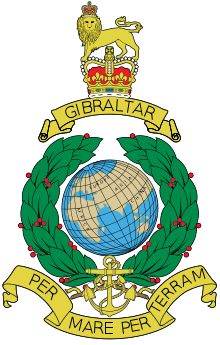 | |
|---|---|
| Deal, Kent | |
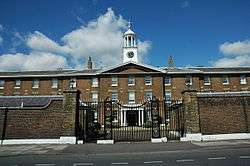 Admiralty Mews (formerly East Barracks) | |
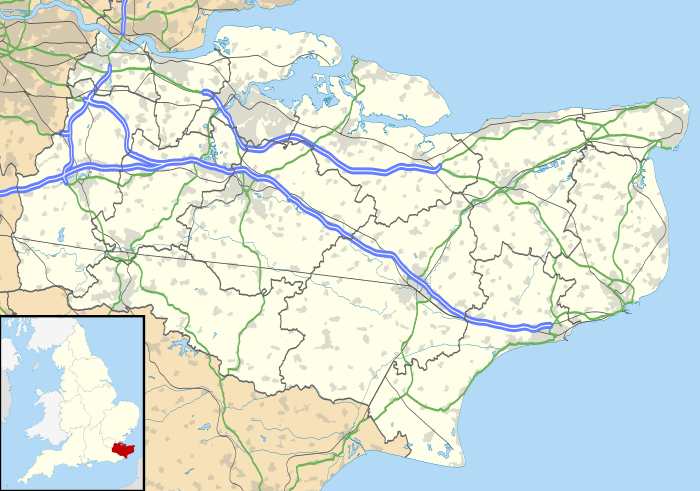 Royal Marine Depot, Deal Location within Kent | |
| Coordinates | 51.2175°N 1.4022°E |
| Type | Royal Marines Base |
| Site history | |
| Built | 1793 |
| Built for | War Office |
| Architect | James Johnson, John Sanders, Edward Holl et al. |
| In use | 1793-1996 |
| Garrison information | |
| Occupants | Royal Marines |
From 1930, Deal served as the headquarters of the Royal Naval School of Music (founded in 1903 to provide Royal Marines bands for ships of the Royal Navy).[3] Renamed the Royal Marines School of Music after the Second World War, it expanded to provide musical training for both junior and senior recruits for all 36 Royal Marines bands.
In 1977 the training Depot closed; the site then became the headquarters of the newly re-formed 41 Commando and was renamed Royal Marines, Deal (however 41 Commando was disbanded just four years later).[3] In 1988 parts of the site were demolished and sold for housing, leaving only the Royal Marines School of Music, which remained at Deal until 1996 whereupon it relocated to HMNB Portsmouth.
History
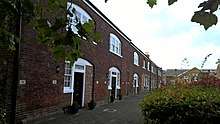
What later became the Royal Marine Depot began as a complex of Army barracks: Cavalry Barracks, South Infantry Barracks and North Infantry Barracks (which began as an Army hospital), together with a separate Royal Naval Hospital.[4] All had been established in the wake of the French Revolution, alongside what was Britain's nearest Naval station to the coast of France.[4] In the early 1800s both hospitals were, in part, converted to provide additional barracks.[5] The whole site was given over to the Royal Marines in the 1860s.[6]
1793-1869
Cavalry Barracks
The cavalry barracks (a single block dating from 1793)[7] housed a single troop of 51 cavalrymen on the first floor with their horses stabled below and officers accommodated in the end sections; it was one of a number of similarly-sized cavalry barracks built around the south and east coast at this time.[5] The 15th Light Dragoons were accommodated there from 1792 to 1815 - a convenient base during the Napoleonic Wars.[8]
By 1848 Cavalry Barracks had expanded and accommodated 7 officers, 114 NCOs and privates, and 90 horses.[4]
South Infantry Barracks
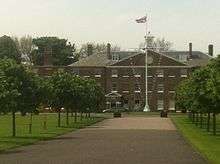
South Infantry Barracks (dating from 1795)[9] were built in line with the cavalry barracks, on the same NE-SW axis, and consisted of three blocks: the central officers' accommodation with clock and cupola (housing 7 field officers, 22 captains and 55 subalterns, together with their staff), flanked by a pair of soldiers' barrack blocks[10] for the soldiers and NCOs (each holding over 900 men).[5] These four buildings (which were designed by James Johnson and John Sanders) are clearly shown on William Mudge's 1797 map of Deal;[11] still in situ, they are said to form "one of the most complete late 18th century barracks in the country".[12]
Army units occupied the barracks from 1795; but following the end of the Napoleonic Wars their requirements decreased, and in 1816 part of the South barracks was instead used as quarters for 'blockade men',[13] who were drafted against a threat of local smuggling (Deal was 'a hot-bed for smugglers' at that time).[14] In 1831 the Coast Blockade for the Suppression of Smuggling was merged into the Coast Guard service; South barracks then became a coastguard station, and this duty continued until 1840. (During this time the Coastguard was akin to a reserve force for the Royal Navy.[14]) Thereafter, the South Infantry Barracks accommodated various Line Infantry regiments until 1869, when the Royal Marines arrived;[6] in 1848 it is described as having accommodation for 33 officers, 688 NCOs and privates, and 16 horses.[4]
North Infantry Barracks
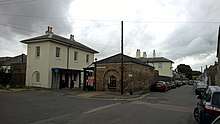
North Infantry Barracks, which opened in 1797, was originally built as an Army hospital, one of the first military hospitals in the United Kingdom. Its design (similar to that of the exactly contemporary Stoke Military Hospital in Stonehouse, Plymouth and Forton Military Hospital in Gosport)[5] consisted of three ward blocks connected by an arcaded passage.[5]
Over time, it began to be used as general barracks accommodation and a sizeable parade ground was laid out in front of the main range,[15] flanked by houses for senior officers and others.[16] By 1848 it is described as having accommodation for 27 officers and 418 NCOs and privates, along with a hospital for 120 patients.[4] In 1858, a barracks school and chapel were built on Canada Road.[6]
Royal Naval Hospital
.jpg)
In the 1750s the Royal Navy had built hospitals at Haslar and Stonehouse, close to the key Naval anchorages of Portsmouth Harbour and Plymouth Sound, respectively. Following the start of the French Revolutionary Wars, the decision was taken to establish a similar hospital at Deal, serving The Downs (another key anchorage).[2] There was already a (privately-run) hospital in Deal serving the needs of sick and injured Naval personnel and this was purchased by the Navy in 1796.[13] A few years later plans were drawn up for its improvement and expansion: it was to have accommodation for 300 patients in wards arranged across all three floors.[2] Wings extended behind the main frontage at either end; the longer wing to the south contained a laundry and wash house.[17] The apsidal room to the rear of the main entrance was the operating theatre, which also served as a chapel.[17] Separate buildings to the west included a cookhouse, the dispensary, 'rooms for insane patients' and a dead house (behind which was laid out a small cemetery). The new hospital was completed in 1804;[4] however in 1812 part of the main block had to be rebuilt after the original structure was destroyed by lightning.[6] Later, additional land was purchased and two pairs of large semi-detached houses were built, for the Governor, Physician, Surgeon and Agent of the hospital.[18]
In 1861, the Royal Marine Depot, Deal was established here (to train recruits for the Royal Marine Light Infantry).[6] Initially staffed by 2 officers, 12 NCOs and 33 privates, it welcomed its first 100 recruits on 10 May that year; by August it was fully operational with 400 recruits in training.[19]
1869-1996
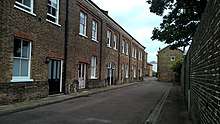
In 1869, the Royal Marine Depot expanded into North Infantry Barracks and South Infantry Barracks, which the Admiralty received in exchange for the Royal Marine Barracks, Woolwich, which were handed over to the War Office following the closure of Woolwich Dockyard.[20] These were then re-named Royal Marine Barracks (North) and Royal Marine Barracks (South), with the Royal Naval Hospital now referred to as the Royal Marine Hospital Barracks[21] The Cavalry Barracks for the time being remained a separate entity, with a wall delineating its boundary with the South barracks.[13] Later, a new row of buildings was built along the line of the boundary, on what is now Wilkinson Drive, providing an Armoury, recreation rooms and a Sergeants' Mess.[22]
To accommodate the expanding depot, three new barrack blocks were added to RM Barracks (North), along with a drill hall behind the main block; additional two- and three-storey blocks were also added to the Hospital Barracks site, alongside the old cemetery at the back.[19] RM Barracks (South) also had new buildings added,[13] including a canteen (opposite the Cavalry barracks) and a gymnasium (built in connection with the RM Physical Training Instruction School, which was established in the Depot in 1871).[6] In the late 19th century an iron-frame drill shed was added to the original Cavalry Barracks, which now backed on to its own three-sided quadrangle of buildings.[7]
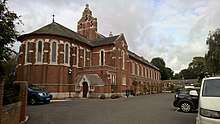
In 1896, a parcel of land was purchased behind South Barracks to serve as a new, larger Drill Field. On what had been the old Drill Field, west of the RM Hospital Barracks, a completely new Hospital was built for the Depot (later referred to as Infirmary Barracks).[6] In 1900 the erstwhile Hospital Barracks was re-named East Barracks, to avoid confusion with the new hospital,[3] with the other areas referred to similarly as North Barracks and South Barracks (the latter now incorporated the old Cavalry Barracks, which served as married men's quarters and Depot offices).[22] In 1905, work was begun on building a new Depot Church (similar in design to those at Eastney and Chatham)[3] on a site alongside the new Drill Field; it was consecrated in January 1907 and dedicated to St Michael and All Angels.[13]
In 1923 the Royal Marine Artillery (which had previously had its depot at Eastney) amalgamated with the RM Light Infantry to form a unified Royal Marines; thenceforward all recruits came to Deal for their basic training.[6] In 1930 the Royal Naval School of Music relocated from Eastney into the East Barracks. During the Second World War, the RN School of Music was evacuated away from Deal and much training activity also moved elsewhere; however, a Non-Commissioned Officers' School was located there, in the East Barracks, from 1940-1946.[6] On 29 October 1940, the Royal Marines Depot was attacked from the air. The Battle of Britain campaign diary records: Army Stations 29 October 1940, Deal: At 1640 hours, three HE bombs were dropped in the barracks, the casualties being 1 Officer and 7 other ranks killed, 6 Officers and 6 other ranks wounded.[23] In 1942, volunteers for the first Royal Marine Commando unit were assembled at Deal, where they undertook initial training and testing.[6]
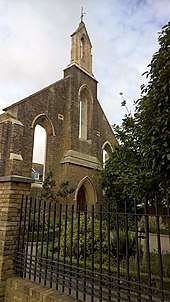
After the war, Deal continued to be used for initial training of recruits (who would then move elsewhere for their commando training or other subsequent training).[24] The (newly-renamed) Royal Marines School of Music returned to Deal in 1950; at the same time the old Divisional Bands of Portsmouth, Plymouth and Chatham were amalgamated to form the Royal Marines Band Service, which had its headquarters in the East Barracks.[6] Boy Musicians (recruited from the age of 14) were accommodated in East Barracks, where they also received general schooling; SNCOs and trained musicians lived in North Barracks (or in the married accommodation by the old Cavalry Barracks).[3] During the 1950s most of the old North Barracks buildings were demolished: the row of officers' houses on the south-west side of the parade ground were replaced in 1951 with a new Dining Hall and Naafi, and on the other side of the parade ground a striking new Drill Hall was erected.[25] The original Georgian hospital/barrack blocks were demolished and replaced by a new accommodation block (containing 96 8-man dormitories and 12 single rooms for SNCOs), which was opened in 1956 by HM Queen Elizabeth The Queen Mother.[24] At the same time the adjacent Victorian barrack blocks were updated. The old chapel and school in Canada Road now served as a Concert Hall and music theory rooms.[3]
In 1977 the Royal Marines Depot, Deal closed as a training base, with all Phase 1 commando training now taking place at Lympstone. The following year, the Physical Training Wing (established in Deal in 1871) was also relocated to Lympstone.[24] Most of the barracks accommodation was then filled by 41 Commando; but after it was disbanded in 1981 the Royal Marines School of Music was left in sole occupancy.[6]
At approximately 8:20 am on 22 September 1989, a recreation centre in the North Barracks, part of the Royal Marines School of Music, was bombed by the IRA; the three-storey building was flattened, resulting in the deaths of 11 musicians, and injuries to 22 other marines.[26] In 1989 a memorial garden was established, close to the site of the bombing, in the grounds of the former chapel and school.[27] In 1993 a memorial bandstand was erected on Walmer Green. No one has ever been convicted over the deaths.[26]
The depot was largely withdrawn from service in 1991 although the Royal Marines School of Music remained on site in the East barracks until 1996, when it relocated to HMNB Portsmouth.[28]
Redevelopment
.jpg)
The Depot site has largely been redeveloped to provide housing, though a large number of historic buildings remain (several of which are Grade II listed). South Barracks, which were converted to residential apartments in the early 21st century, are now known as the "Cavalry Barracks";[30] the East barracks were converted into private housing in 1997 and are now known as "Admiralty Mews".[30] The modern North Barracks buildings were demolished; very little survives of the Georgian barracks here, except along the north-east boundary of the site: buildings flanking the main gate (including the former guard house),[31] and a row of houses built to accommodate officers and surgeons; this area is now known as "The Churchills".[32] Infirmary Barracks closed in 1988 and the buildings were demolished to make way for a private housing development now known as "Marine Mews".[30]
In 2003 the former Concert Hall was destroyed in a fire. One wall has been left standing and the adjacent memorial garden has been preserved in place.[27]
References
- Thomas, Garth (1994). Records of the Royal Marines. London: PRO Publications.
- Coad, Jonathan (2013). Support for the Fleet: Architecture and engineering of the Royal Navy's bases, 1700-1914. Swindon: English Heritage.
- Lane, Andrew (2000). Royal Marines Deal: a pictorial history. Tiverton: Halsgrove. ISBN 1 84114 081 3.
- Lewis, Samuel (1848). A Topographical Dictionary of England (7th ed.). London: S. Lewis & co. p. 20.
- Douet, James (1998). British Barracks 1600-1914: their Architecture and Role in Society. London: The Stationery Office.
- "Historical Timeline: The Royal Marines in Deal and Walmer". Royal Marines Heritage Trails. Retrieved 14 June 2019.
- Historic England. "Block 20 of South Barracks, Royal Marines Depot (1254009)". National Heritage List for England. Retrieved 20 June 2019.
- Cannon, Richard (1841). Historical Record of the Fifteenth or the King's Regiment of Light Dragoons, Hussars containing an account of the formation of the regiment in 1759 and of its subsequent services to 1841. John W. Parker. p. 69.
- Historic England. "Building 12 (Officers' Mess), South Barracks (1363449)". National Heritage List for England. Retrieved 20 June 2019.
- Historic England. "Building 13 (North Barrack Block), South Barracks (1259236)". National Heritage List for England. Retrieved 20 June 2019.
- "Deal Area in Maps". East Kent History. Retrieved 18 June 2019.
- Historic England. "Building 129 (Guard House), South Barracks (1259176)". National Heritage List for England. Retrieved 20 June 2019.
- "Deal South Barracks Conservation Area Appraisal" (PDF). Dover District Council. Retrieved 18 June 2019.
- Webb, William (1976). Coastguard! An official history of HM Coastguard. London: HMSO.
- "North Barracks Parade Ground and Layout". Royal Marines Heritage Trails. Retrieved 18 June 2019.
- Historic England. "Building 66 and 67 and attached rear wall North Barracks (1259276)". National Heritage List for England. Retrieved 20 June 2019.
- "Naval hospital, Deal, Kent: plan (1800)". Royal Institute of British Architects. Retrieved 18 June 2019.
- Historic England. "Nos 1-2, The Strand (Royal Buildings and Zeebrugge House) (1261447)". National Heritage List for England. Retrieved 20 June 2019.
- "The History of Admiralty Mews". Royal Marines Heritage Trails. Retrieved 19 June 2019.
- "Statement of Sums Expended, compared with those Granted, for Army Services, for the year ended 31 March 1870". Parliamentary Papers. 38: 129. 1871.
- "Detailed Old Victorian Ordnance Survey 6 inch to 1 mile Map (1888-1913) Deal, Kent". Archaeology UK. Retrieved 18 June 2019.
- "1911 Admiralty Depot Map". Royal Marines Heritage Trails. Retrieved 13 June 2019.
- "The Battle Of Britain Home Page: Battle of Britain Campaign Diary. 29 October 1940". The Royal Air Force. Archived from the original on March 15, 2004. Retrieved 1 February 2010.CS1 maint: unfit url (link)
- Smith, Peter C. (1974). Per Mare Per Terram: a History of the Royal Marines. St Ives, Cambs.: Balfour.
- photos
- "Concert recalls 11 killed by IRA". BBC News. 12 July 2009. Retrieved 29 August 2009.
- "Deal bomb memorial 'safe'". BBC News. Retrieved 20 June 2019.
- "Walmer and the Royal Marines". Walmer.web. Retrieved 22 May 2016.
- "Top design award for converted rail shed". www.kentonline.co.uk. 2 December 2005. Archived from the original on January 17, 2014. Retrieved 16 January 2014.CS1 maint: unfit url (link)
- "WalmerWeb: Local History - The Royal Marines". walmerweb.co.uk. Retrieved 24 September 2015.
- Historic England. "Building 69 (guardhouse), North Barracks (1259278)". National Heritage List for England. Retrieved 20 June 2019.
- Historic England. "Building 68 and Attached Rear Wall, North Barracks (1259277)". National Heritage List for England. Retrieved 20 June 2019.
External links
Publications
- Lane, Andrew, 2000. Royal Marines Deal. A pictorial history, Halsgrove Publishing, ISBN 1841140813